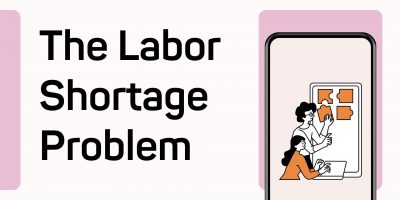
What is Employee Onboarding in HR?
As the search for quality candidates in today’s highly competitive market is relentless, optimizing the onboarding process and improving the employee experience should not be overlooked.


CEO & Business Coach at Kate Langford Career Consulting

Management Consultant & Leadership Coach at Indispensable Consulting

Founder & CEO of TalentLab

SEO Manager at Diggity Marketing

CMO at ProofHub

Senior Associate Attorney at Shipkevich PLLC’s Miami Office
The last year has been challenging for everyone. The shifts caused by the global pandemic took a toll on every worker and organization worldwide. It exacerbated the daily issues at the workplace, loading even more tasks and responsibilities on workers’ (already full) plates. Thus, creating the so-called Great Resignation trend.
In collaboration with several managers and HR professionals, this article focuses on “The Great Resignation,” the reasons behind it, and the trends surrounding it.
According to the U.S. Bureau of Labor Statistics, up to 3% or 6.3 million Americans quit their jobs last November. Another interesting statistic from the Bureau shows that most of these quits are generally voluntary separations initiated by the employee.
Sure, some of those employees were changing careers for better conditions, but many of them were leaving the workforce for good. Why is that?
Many surveys and polls sought an answer to that question. In fact, some even tried predicting future steps of employees. One of them, Qualtrics, in their annual Employee Experience Trends Report for 2022, predicts that 5% fewer workers plan to stay in their current job than in 2021. From those, women in middle management positions are three times more likely to resign or find a new job.
But it’s not only women but middle managers, in general, who are also less likely to keep their current jobs in 2022. To put that in numbers, only 63% of middle managers plan to stay at their jobs in 2022 compared to 2021, when that number percent reached 83%.
Kate Langford, the CEO & Business Coach at Kate Langford Career Consulting, explained that further: “People want to work for a company:
Reflecting on the COVID-19 pandemic, she added: “One thing that this pandemic has done for us is that it challenges us to rethink what matters most to us in life – and being happy is usually right at the top of the list. Money alone isn’t enough to make us love a job.
Neither is the ability to do it well – there needs to be something more!
We’re living in a time when the sky is the limit in terms of opportunities, and people are tired of simply settling, when in fact achieving our wildest dreams is actually also an option!”
To understand this resigning trend among middle managers, first, we must understand the nature of their jobs, what and who they are dealing with, the main risks of their careers, and how they are addressing them.
Even though there are more strict definitions of middle management or intermediate management, it’s best to think of middle managers as connecting leaders. Their hierarchical level in the organization allows them to develop relations with those at the top of the organization and those at the bottom.
This bilateral aspect of middle managers’ jobs translates as a highly challenging and stressful type of role. Hence, effective middle managers are expected to be proactive leaders to direct reports and involve followers to top managers.
Simply put, middle management refers to the middle layers of a hierarchical organization. This type of management-level reports to higher managers and at the same time manages at least one subordinate level of managers.
The middle managers are directly involved in decision-making and setting goals and are indirectly responsible for subordinates’ performance and productivity. They follow the instructions and objectives of top-level managers, create a strategy around them, and make sure low-level managers stick to it.
Besides being responsible for departments and units in the organization, middle managers are also expected to be aware of all events and activities. Middle managers must cultivate a supportive atmosphere where all employees feel happy and satisfied to do this efficiently.
In fact, James Kerr, a management consultant and leadership coach at Indispensable Consulting, shared with us his views “The middle management team makes or breaks every company!
They have a tough job because they must interpret the strategies developed by top leadership and translate them into actionable items that can be executed by the rank and file. If they fail to do this well, an organization can fail.
So, yes, they’re leading the resignation wave because they’re tired and no longer want to assume the burden of keeping things afloat during these incredibly uncertain times, especially when other opportunities are widely available elsewhere.”
This trend of employees voluntarily yet massively resigning from their jobs started at the beginning of 2021. Anthony Klotz, a professor of management at Texas A&M University, used the term “The Great Resignation” to describe it.
While many investigate and try to find the root cause of this tendency, probably they won’t find a single reason behind it. Most likely, it’s a symbiosis of the disruptive effect of the pandemic, wage stagnation, the rising cost of living, and more.
According to Paola Carranco, the Founder and CEO of TalentLab, “The new world of work has challenged us in many ways, and humans have definitely changed their views, preferences, dreams, and way of living.
The social, economic, and health crisis that we have been living in has moved us all and has shown the deep crashes we have between companies and employees – one of the effects is the great resignation.
Managers that try to manage the old way and do not understand that they are responsible for the experience of other humans at work will have to deal with the consequences.
People need inspiration, space for growth, want to experience a safe space to be themselves, bring their ideas to the table, have a meaningful job with a purpose. New managers must embrace the new world of work by being agile, inclusive, genuinely caring for their people, but most of all, being human.”
Some even describe it as a workers’ revolution directed against organizations’ abusive behavior, low-wage jobs, and employees’ exploitation.
But why is middle-level management leading the great resignation? The abovementioned Qualtrics survey reports that burnout is the number one reason for resigning among middle managers.
Their responsibilities include supporting employees’ mental health, promoting positive company culture, and focusing on diversity, equity, and inclusion.
But this supportive atmosphere shouldn’t be only a privilege of middle managers’ subordinates. By being constantly pulled in two directions, middle managers themselves need to feel supported, especially during uncertain times like these.
Nathan Hughes, the Digital Marketing and SEO manager at Diggity Marketing, agrees with this: “With experience, I can tell you that middle managers are driving ‘The Great Resignation’ with a higher force because these are the people who shape the experience of every employee.

To address the burnout, he added: “To deal with burnout, what I always ask my colleagues to do would be to seek a shoulder to lean on and stay relaxed. With this, you get to weigh in your options, seek advice and take steps ahead for a brighter future.
As a company, we have prioritized the mental health of our employees and have ensured to do everything in our might to empower their trust in us. This policy turnover has helped us move ahead efficiently, hearing their concerns and providing solutions with increased employee retention.”.
According to a survey by Harvard Business Review, high turnover rates are on the rise, especially among employees between 30 and 45 years. The average increase is more than 20% between 2020 and 2021.
Even though this resignation trend was previously tightly connected to younger employees (between 20 and 25 years), things have changed over the last year.
Vartika Kashyap, the CMO at ProofHub, shared her views on this and pinpointed some of the factors that have driven mid-level employees to resign:
“True, the great resignation is being led by middle management. A few elements may explain why these mid-level employees have accounted for most of the resignations.
To begin with, the change to remote work has probably made companies believe that hiring someone with less experience is riskier than usual because new employees will not receive in-person training and coaching. This would increase demand for mid-level employees, providing them more bargaining power when looking for new jobs.
It’s also possible that many of these mid-level personnel have been putting off moving out of their jobs owing to the pandemic’s uncertainty, implying that the surge we’ve witnessed in recent months is the product of more than a year’s worth of resignations.
And, of course, after months of high workloads, hiring freezes, and other pressures, many of these individuals may have simply hit a breaking point, forcing them to reconsider their work and life goals,” she concluded.
Another undoubtful fact about the great resignation is that women, especially those in middle management positions, are three times more likely to resign or find a new job.
According to a recent survey by Gusto’s, the gender gap was widest in August 2021 when the quit rate among women was 1.1 percentage points higher than men.
Other sources report that:
While some of these women were pursuing better career opportunities and higher pay and left their current jobs voluntarily, many were forced to make this decision. Taking care of children, families (and the elderly) was the major reason women quit.
Melanie Trogolo, a Senior Associate Attorney at Shipkevich PLLC’s Miami Office, shared her thoughts on this: “I am in a profession that is synonymous with burnout. As an attorney, you are told the path to success requires choosing a job over family and fun. This is something that is being seen in many fields, and COVID-19 restrictions are changing that.
I turned down a national firm with more pay to join Shipkevich, PPLLC, because the shareholder, Felix, had in place a flexible work model. We can work whatever hours we choose to work and fully remote, and no one is expected to come back to the office, ever. This helps me manage my life with my daughter as a single mother and not sacrifice my career.
So many employers are not evolving, and it is causing high turnover rates burnout and leading to the Great Resignation. Employees want to work, but they also value enjoying life. If employers don’t start thinking about their employees and their families, I don’t see retention rates changing,” she finished.
However, this gap doesn’t end with age and gender. It affects race, too. A 2020 SHRM report shows that many employees left the workforce because of various race and ethnicity issues.
For instance, as a reason to quit their jobs, employees have listed:
While it is early to predict and bring any conclusions, it sure is time to opt for a data-driven approach to improving retention and turnover rates. Employers and organizations should obtain and leverage the data of these resignation trends to determine the number of people quitting altogether with the reasons behind it and the things that can be done to minimize or prevent them in the future.
SEO Manager at Shortlister
Browse our curated list of vendors to find the best solution for your needs.
Subscribe to our newsletter for the latest trends, expert tips, and workplace insights!

As the search for quality candidates in today’s highly competitive market is relentless, optimizing the onboarding process and improving the employee experience should not be overlooked.

Uncover the true potential of ATS and CMS in revolutionizing your recruitment efforts.

Would a top candidate choose your posting over a competitor’s in under a minute? The answer depends on whether your job ad sells opportunity or just lists demands.

Explore the reasons behind the labor shortage in the US and the strategies to overcome this global problem. Gain insightful advice on how leading experts attract high-quality talent in a tight labor market.
Used by most of the top employee benefits consultants in the US, Shortlister is where you can find, research and select HR and benefits vendors for your clients.
Shortlister helps you reach your ideal prospects. Claim your free account to control your message and receive employer, consultant and health plan leads.